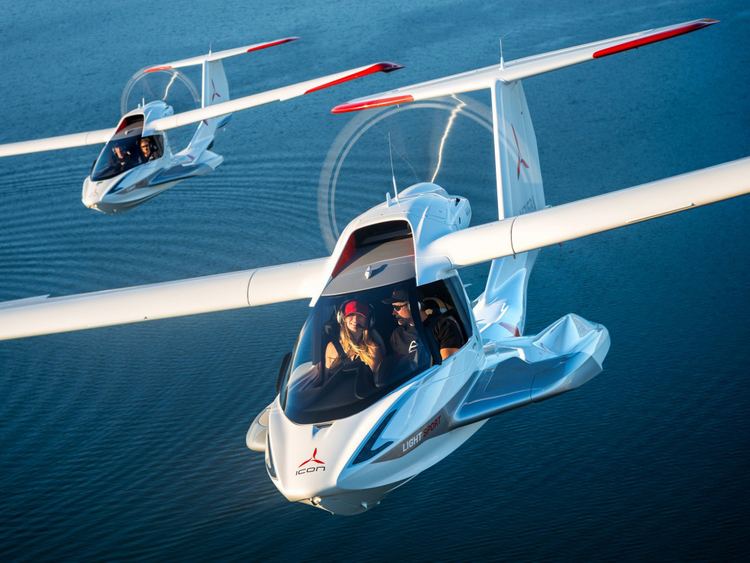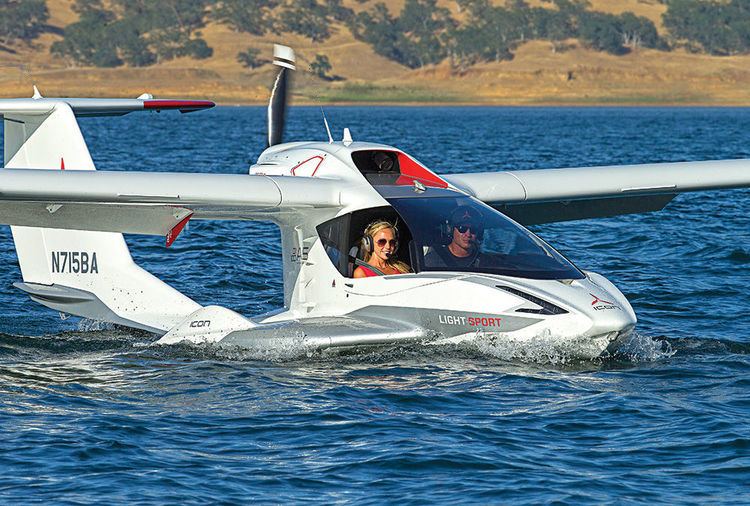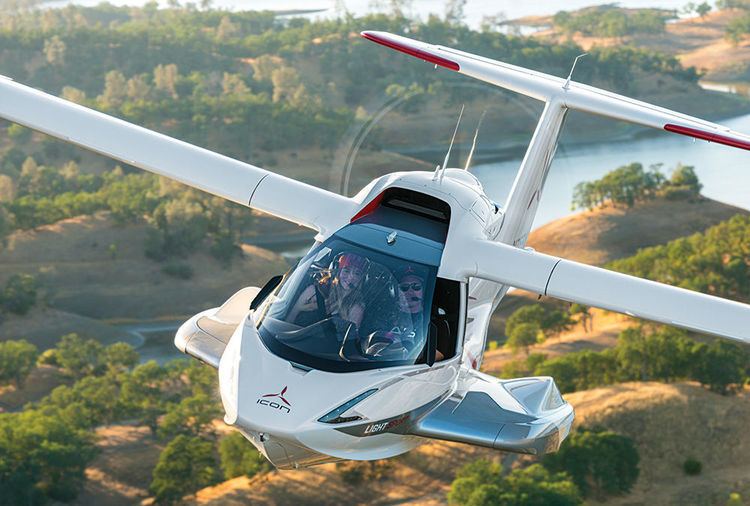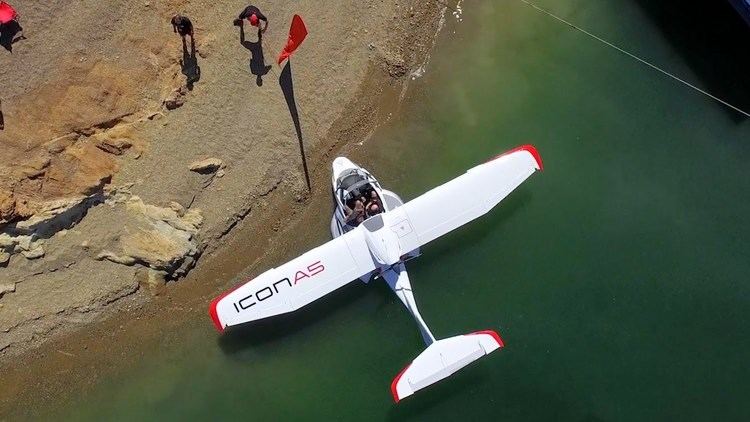Range 556 km Length 6.7 m Wingspan 10 m | Top speed 193 km/h Weight 454 kg Unit cost 189,000–189,000 USD | |
The ICON A5 is an American amphibious light-sport aircraft being developed by ICON Aircraft. A concept aircraft was first flown in 2008, and creation of the production tooling began in December 2012. The first production aircraft made its first flight on July 7, 2014, and made its public debut at EAA AirVenture Oshkosh on July 27, 2014.
Contents
- Flying the icon a5 amphibious light sport aircraft aintv
- Design
- Development
- Purchasers agreement controversy
- Awards
- Specifications estimated
- References

Flying the icon a5 amphibious light sport aircraft aintv
Design
The A5 is a high-wing flying boat-type amphibious monoplane with a carbon fiber airframe and retractable undercarriage. It seats two people in an enclosed 46-inch-wide (116.8 cm) cockpit and is powered by a single 100 hp (75 kW) Rotax 912 iS engine driving a three-bladed pusher propeller. Dornier-style sponsons provide hydrodynamic stability, housing the retracted main landing gear, and act as a step for crew and passenger. The wings can be folded aft for ground transport and storage. Equipment includes an angle of attack indicator, an unusual feature in general aviation aircraft. A whole-airframe Ballistic Recovery Systems parachute is optional, except for in U.S.-registered A5s where it is mandatory, due to ICON's exemption to the U.S. LSA weight limit. The A5 uses many different design elements to provide a manageable stall recovery.
Development

ICON Aircraft positions the A5 with a recreational focus, stating that the aircraft competes with powersports vehicles such as ATVs, motorcycles, watercraft, and snowmobiles, rather than other airplanes. ICON CEO Kirk Hawkins said "it's not about the usual metrics of speed, range, payload, altitude, and complex cockpits. It's about getting you out there and interacting with your world." As part of this effort the cockpit interior was designed by BMW designers. ICON's media debut in Wired and coverage in the mainstream media showed that theer was significant interest from outside the aviation community, and ICON has reported that 35% of its customers are not pilots.

A prototype was constructed from 2007 to 2008, and made its first flight in July 2008. In January 2009, the company announced completion of the first phase (27 flights) of a three-phase testing program, including water handling. In February 2009, the prototype entered the second phase of testing to refine aerodynamic and handling qualities. In 2011, an updated "spin-resistant" wing was flight tested, and finished in February 2012. The design meets FAR Part 23 type certified requirements by employing a cuffed wing with multiple proprietary airfoils which change along the wing's span. Lotus Engineering replaced Designworks the same year to develop an "automotive style" aircraft interior and assist with development of lightweight component manufacturing.
In July 2012, the company applied for a Federal Aviation Administration LSA rule exemption to raise the weight of the A5 above the maximum weight for amphibian LSAs, citing that the required structure to make the aircraft spin resistant necessitated a gross weight of 1,680 lb (762 kg). In May 2013 the FAA requested more details on the procedures used by Icon to test the spin resistance of the aircraft at the higher weight. The FAA also requested a signed statement from the company indicating that the aircraft meets the spin resistance criteria specified for light aircraft type certification in FAR 23.221 (a)(2). In July 2013 the FAA granted the weight increase.

Production delivery dates have been adjusted from initial estimates. In June 2011, the company announced that it had procured an additional US$25 million investment, which was "needed to allow the company to complete engineering development work and enter production - possibly as early as next year [2012]." By August 2011, the company stated that it had sold positions for 694 A5s, up from 400 initially sold at AirVenture 2009. A promotion in conjunction with EAA Young Eagles raised more than US$28,000 for the youth flight program.
On August 6, 2012, Icon announced that Cirrus Aircraft would produce composite airframe components for the A5 at its Grand Forks, North Dakota facility. The airframe parts will be shipped to Icon's Tehachapi, California plant for final assembly. In August 2012 the first production aircraft was anticipated for delivery in mid-2013 against 850 customer orders that the company says it was holding at that point.
In December 2012, production of the tooling master molds began, with horizontal tail fin masters being delivered to Cirrus Aircraft that month. Wing skin masters were delivered in February 2013.
On June 20, 2013, the company announced that it had organized production funding of over US$60 million, with final funds being provided by a Chinese investor.
By July 30, 2013, the estimated production price had risen to US$189,000 (from the company's initial estimated price established in 2008 of US$139,000) and further raised to US$247,000 in 2015.
On October 2, 2013, the construction of production tooling was announced, which "will lead up to the assembly of the first pre-production aircraft to be completed in mid-2014."
On July 27, 2014, the first production A5 was unveiled at EAA AirVenture Oshkosh. This aircraft was constructed between January and June 2014 at company headquarters in Tehachapi, California, and first flew on July 7. Icon stated that two additional aircraft would be constructed to "verify performance and complete FAA approval". The company at that time planned to begin customer deliveries in May 2015.
The first customer aircraft was flown in May 2015, but deliveries could not commence until the company underwent an FAA audit, which was completed on June 11, 2015.
In June 2015 the company indicated that they had 1,250 orders for the A5 and plans to build 500 per year by 2017 at its new location in Vacaville, California.
On July 20, 2015, Icon presented the first production A5 as a donation to EAA youth group Young Eagles, although the aircraft was taken back to the factory on a trailer and not left with the EAA.
In August 2015, the A5 was flown by several aviation journalists, which resulted in overwhelmingly positive reviews, singling out the aircraft's handling and cockpit ergonomics.
In May 2016, the company announced that only 20 aircraft would be completed in 2016, instead of the previously planned 175 and that all these would go to training centers. Customer deliveries were announced as being delayed until 2017 at the earliest, due to the need to improve the manufacturing processes to build the aircraft design. The company also announced that, as a result of issues involving starting production, it would lay off 60 employees and terminate 90 contractors, leaving 160 employees at work. The CEO indicated that the company has the investors required to continue operations through this period, before production is increased and the company can become profitable. By May, the company reported having completed production of 7 aircraft, with 11 more partially completed.
Purchaser's agreement controversy
In April 2016 the ICON A5 purchaser's agreement was made public and was noted by the aviation media as containing many controversial elements not usually found in aircraft purchase agreements. These include contractually-required pilot training, maintenance, agreements not to sue, the requirement for factory airframe overhauls every 2,000 hours, or ten years (whichever comes first), and a limit on the aircraft's life of 6,000 hours, or thirty years. Furthermore, each aircraft would be equipped with a camera and recorder to monitor pilot behavior, that is owned by the manufacturer but must be maintained by the owner. Owners would have to agree to be "supportive" of the company. Future owners were required to sign the same agreement or face penalties.
The agreement was widely criticized by the aviation media, including Plane & Pilot, the Aircraft Owners and Pilots Association, AVweb and the Experimental Aircraft Association, among others.
In responding to the criticism, ICON CEO Kirk Hawkins issued an open letter on April 8, 2016, that said in part, "To those following the ICON Aircraft Purchase Agreement discussion: We hear you–loud and clear. And I promise, we’re listening carefully...If we need to improve our contract to help safely grow our industry–we will."
The company refused interviews to several aviation media outlets on the subject, including AVweb and Aero News Network. AVweb's Paul Bertorelli wrote, "We and other media outlets repeatedly contacted Icon for questions and clarifications, only to be either ignored, rebuffed or given summarily vague answers. At AVweb, we now have an amusing game with Icon. We schedule interviews and they cancel them. Two were cancelled last week. Hey, no fair complaining if we can't discuss any of this."
In May 2016 the company admitted that the released contract had been a mistake. Company CEO, Kirk Hawkins, stated, "It should not have gone out in the form it went out without an explanation. [Customers] had a right to be taken aback." The company issued a revised contract that removed many, but not all controversial elements. Removed were the audio and video cockpit recorder, the "responsible flyer" clause, limiting the owner's cost of the mandatory airframe overhaul to $15,000 and removing the 30-year life limit. Retained were the agreement not to sue, the requirement for company-approved training and the requirement that the agreement bind future owners.
Awards
Specifications (estimated)
Data from ICON Aircraft
General characteristics
Performance
Avionics
